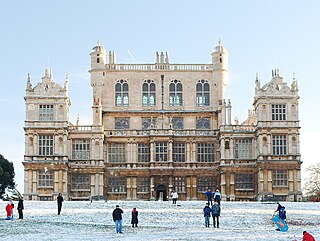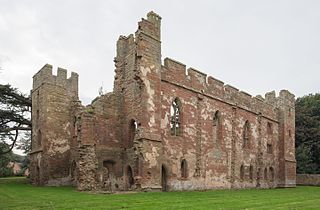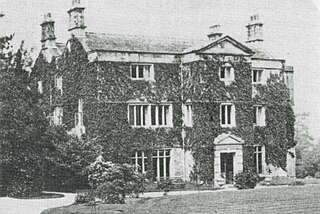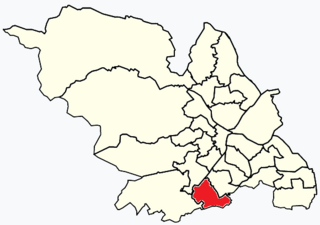
Oakworth Hall is located in Oakworth, West Yorkshire, England. The manor house was rebuilt in the 17th century, but has a history dating back to 1066. The building overlooks the Worth Valley, facing south towards Haworth.

Wollaton Hall is an Elizabethan country house of the 1580s standing on a small but prominent hill in Wollaton Park, Nottingham, England. The house is now Nottingham Natural History Museum, with Nottingham Industrial Museum in the outbuildings. The surrounding parkland has a herd of deer, and is regularly used for large-scale outdoor events such as rock concerts, sporting events and festivals.

Wallingwells is a small civil parish and hamlet in the Bassetlaw district of Nottinghamshire, England, with a population at the 2001 census of 22. The population remained less than 100 at the 2011 census. Details are included in the civil parish of Carlton in Lindrick. It lies about five miles north of Worksop.

Broughton is a village and civil parish in the Craven district of North Yorkshire, England. The village is on the A59 road approximately 3 miles (5 km) west of Skipton.

This is a list of the High Sheriffs of the English county of Nottinghamshire.

Woolley Hall is a country house in Woolley, West Yorkshire, England. It is a Grade II* listed building.

Acton Burnell Castle is a 13th-century fortified manor house, located near the village of Acton Burnell, Shropshire, England. It is believed that the first Parliament of England at which the Commons were fully represented was held here in 1283. Today all that remains is the outer shell of the manor house and the gable ends of the barn. It is a Grade I listed building on the Statutory List of Buildings of Special Architectural or Historic Interest.

Worksop Manor is a Grade I listed 18th-century country house in Bassetlaw, Nottinghamshire. It stands in one of the four contiguous estates in the Dukeries area of Nottinghamshire. Traditionally, the Lord of the Manor of Worksop may assist a British monarch at his or her coronation by providing a glove and putting it on the monarch's right hand and supporting his or her right arm. Worksop Manor was the seat of the ancient Lords of Worksop.

Caunton is a village and civil parish in the Newark and Sherwood district of Nottinghamshire on the A616, six miles (9.7 km) north-west of Newark-on-Trent, in the NG23 postcode. The population of the civil parish at the 2011 Census was 483.

Bramham Park is a Grade I listed 18th-century country house in Bramham, between Leeds and Wetherby, in West Yorkshire, England.

Whiteley Wood Hall was an English country house which was demolished in 1959. It stood off Common Lane in the Fulwood area of Sheffield, England. The hall’s stables and associated buildings are still standing and along with the surrounding grounds now serve as an outdoor activities centre for Girlguiding Sheffield. The stables are a Grade II listed building.

Stanton Hall is a privately owned country house at Stanton in Peak in the Derbyshire Peak District, the home of the Davie-Thornhill family. It is a Grade II* listed building.

Parwich Hall is a privately owned 18th-century mansion house at Parwich, near Ashbourne, Derbyshire Dales. It is a Grade II* listed building.

Colwick Hall was an English country house in Colwick, Nottinghamshire. It is now a hotel. The building is Grade II* listed.

Peel Hall is a country house near the village of Ashton Hayes, Cheshire, England. It is recorded in the National Heritage List for England as a designated Grade II* listed building. It was built as a mansion in 1637, but was much reduced in size by 1812, and was later used as a farmhouse. It is constructed in sandstone and has slate roofs. Its architectural style is Jacobean.

Duxbury Hall was a 19th-century country house in Duxbury Park estate in Duxbury Woods, Duxbury, Lancashire that has been demolished.

The Corbet family is an English family of Anglo-Norman extraction that became one of the most powerful and richest of the landed gentry in Shropshire. They trace their ancestry to two barons found in the 1086 Domesday Book and probably derive from the Brioton and Essay region, near Sées in Normandy. The name Corbet derives from the Anglo-Norman word corb, meaning "crow", matching the modern French corbeau. Variants of the name include: Corbet, Corbett, Corbitt, Corbit, Corbetts, Corbete, Corben and possibly the variant of Corbin. It has cognates in other languages: the Spanish name Cuervo, for example, which generally means a raven or rook. The underlying derivation is from the Latin word corvus, crow. Generally it is thought to be a jocular reference to a person who was thought to resemble a crow: in hair colour, tone of voice or shape of nose. However, the Scandinavians believed that a raven on the battlefield was a beneficial omen and ensured victory.

Tonge Hall is a Grade II* listed Elizabethan manor house in Tonge, Middleton, Greater Manchester, England.

Teversal Manor is a small Grade II listed 17th-century country house in Teversal, Nottinghamshire, some 5 km west of Mansfield.




















